System for evacuating the residual heat from a liquid metal or molten salts cooled nuclear reactor
a liquid metal or molten salts cooled, nuclear reactor technology, applied in the direction of tubular elements, lighting and heating apparatus, tubular conduit assemblies, etc., can solve the problems of difficult water use, high cost, and insufficient reliability according to known solutions, so as to reduce the drawbacks of water use.
- Summary
- Abstract
- Description
- Claims
- Application Information
AI Technical Summary
Benefits of technology
Problems solved by technology
Method used
Image
Examples
Embodiment Construction
[0014]With reference to FIG. 1, a nuclear reactor 1 of a substantially known type, in particular a reactor using liquid metal or molten salts as primary cooling fluid, comprises a tank 2, which extends around a central axis A and is covered by a roof 3. Arranged within the tank 2 is a core 4, cooled by a primary fluid 5 (constituted, for example, by sodium, lead, lead-bismuth eutectic or molten salts), which fills the tank 2 up to a given height of the surface 6 of the fluid. Likewise housed in the tank 2 are primary heat exchangers, which transfer the power generated in the core 4 to a secondary circuit, as well as circulation pumps, machines for transfer of the fuel, and structures for supporting the instrumentation and control bars, none of which is represented in so far as they are not pertinent to the present invention.
[0015]The reactor 1 is provided with a system 7 for evacuation of the residual heat, comprising heat exchangers 8 housed circumferentially in the tank 2 and co-o...
PUM
| Property | Measurement | Unit |
|---|---|---|
| thermal conductivity | aaaaa | aaaaa |
| pressure | aaaaa | aaaaa |
| thickness | aaaaa | aaaaa |
Abstract
Description
Claims
Application Information
 Login to View More
Login to View More - R&D
- Intellectual Property
- Life Sciences
- Materials
- Tech Scout
- Unparalleled Data Quality
- Higher Quality Content
- 60% Fewer Hallucinations
Browse by: Latest US Patents, China's latest patents, Technical Efficacy Thesaurus, Application Domain, Technology Topic, Popular Technical Reports.
© 2025 PatSnap. All rights reserved.Legal|Privacy policy|Modern Slavery Act Transparency Statement|Sitemap|About US| Contact US: help@patsnap.com



